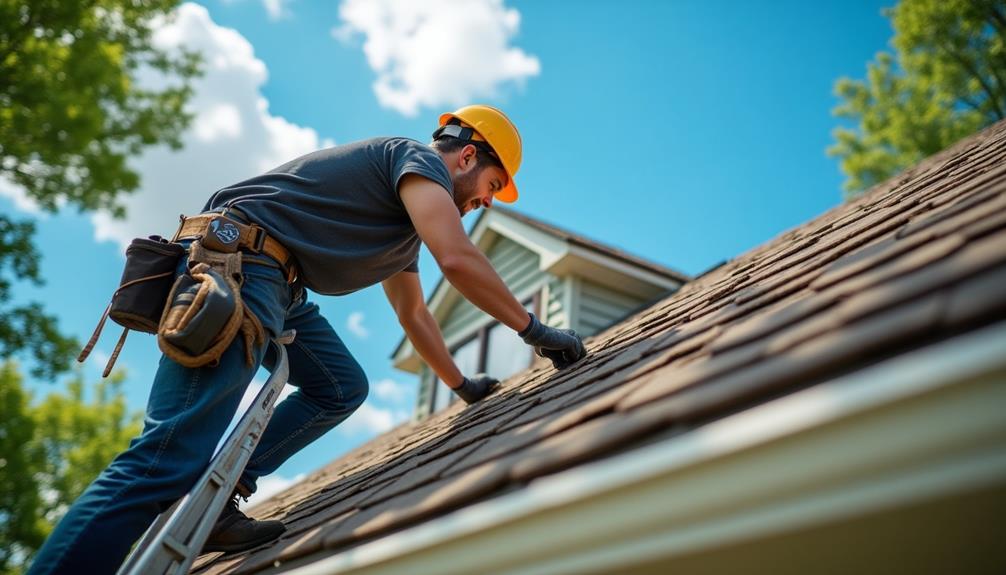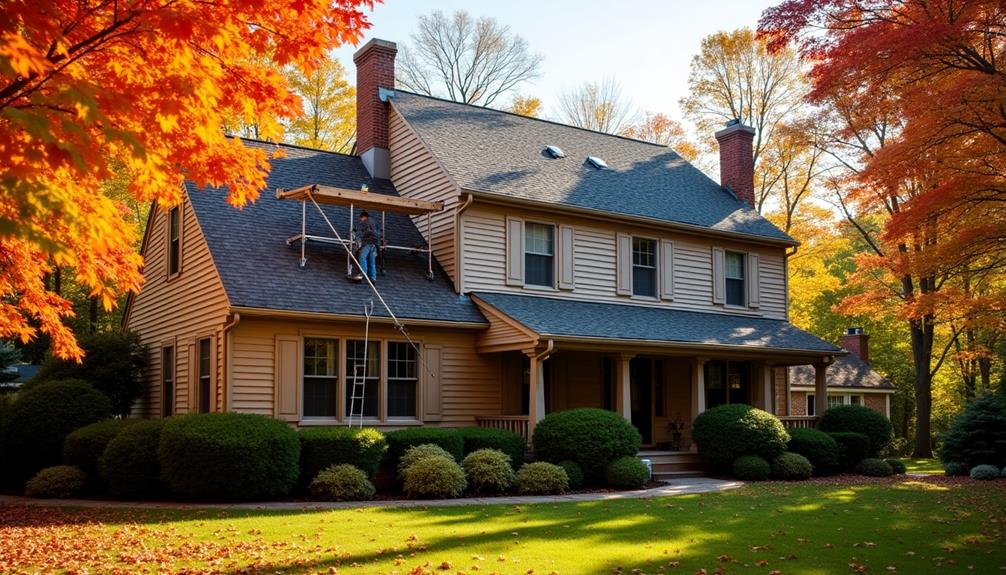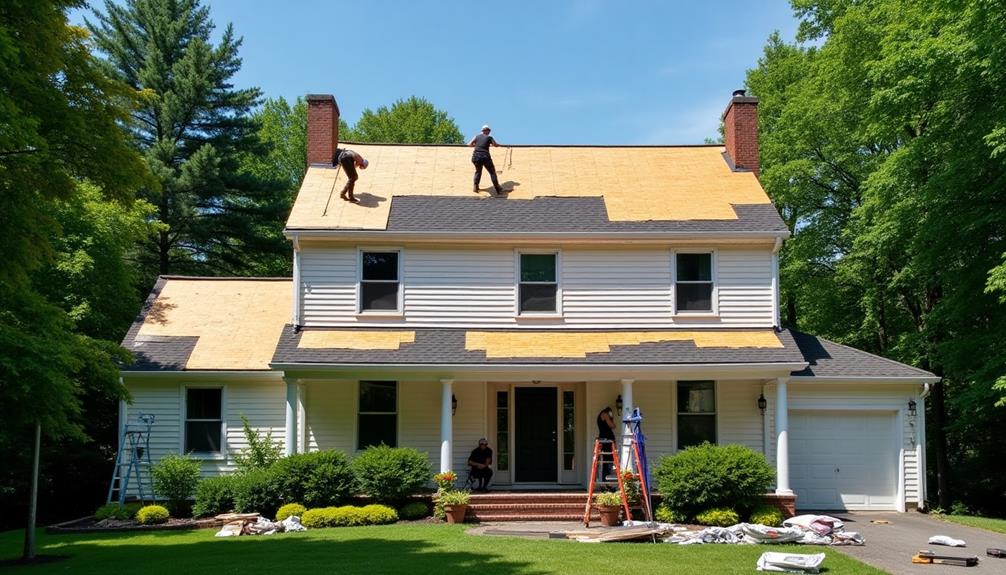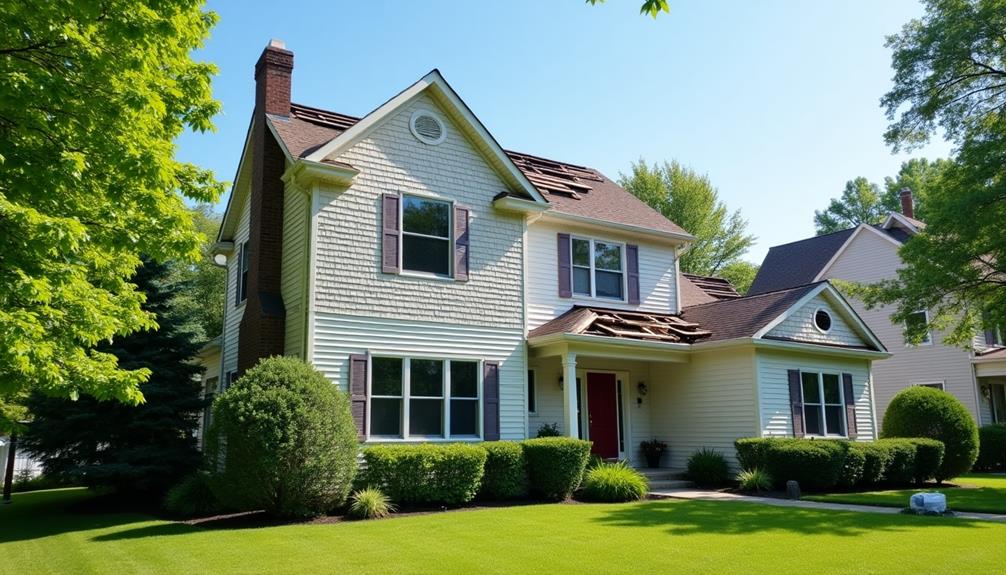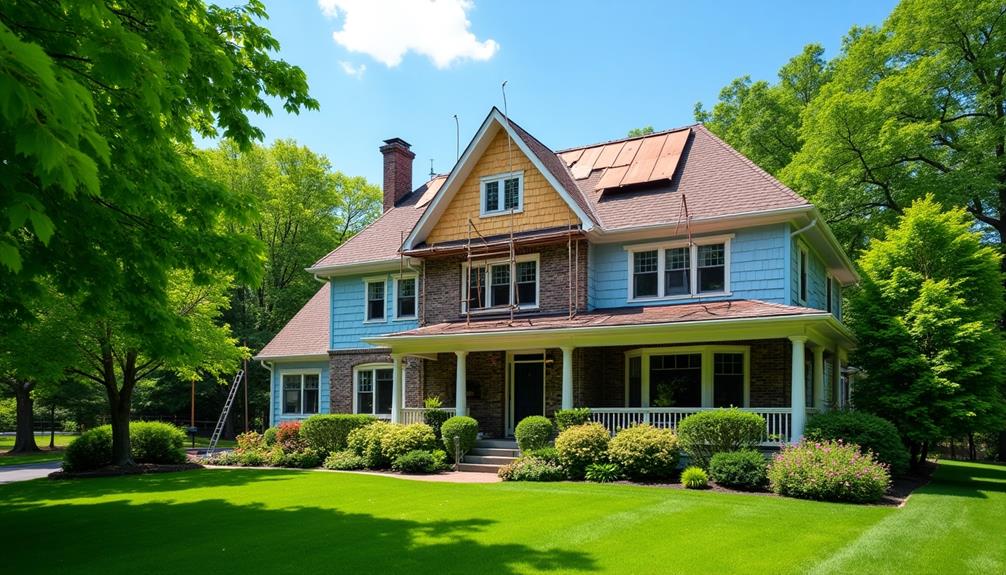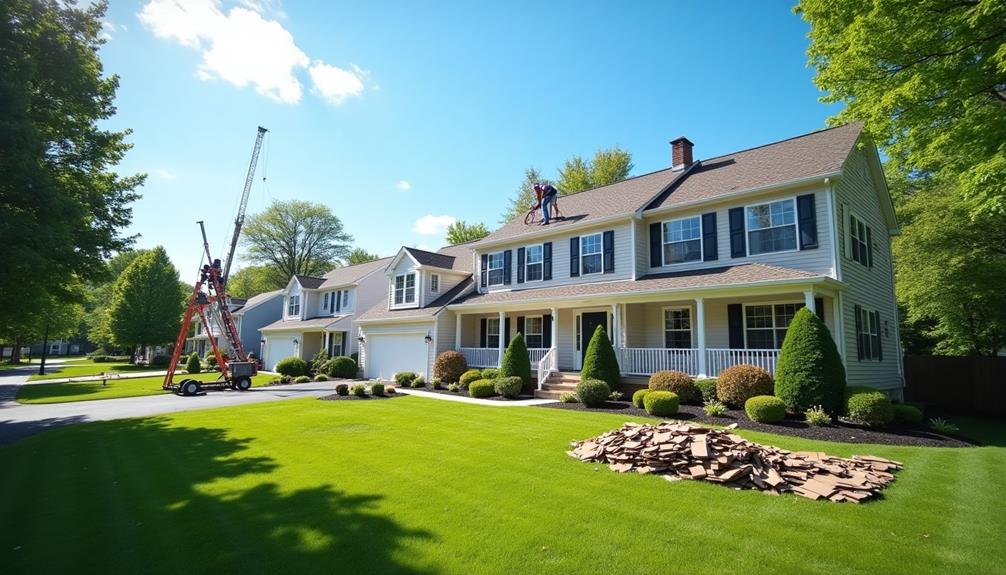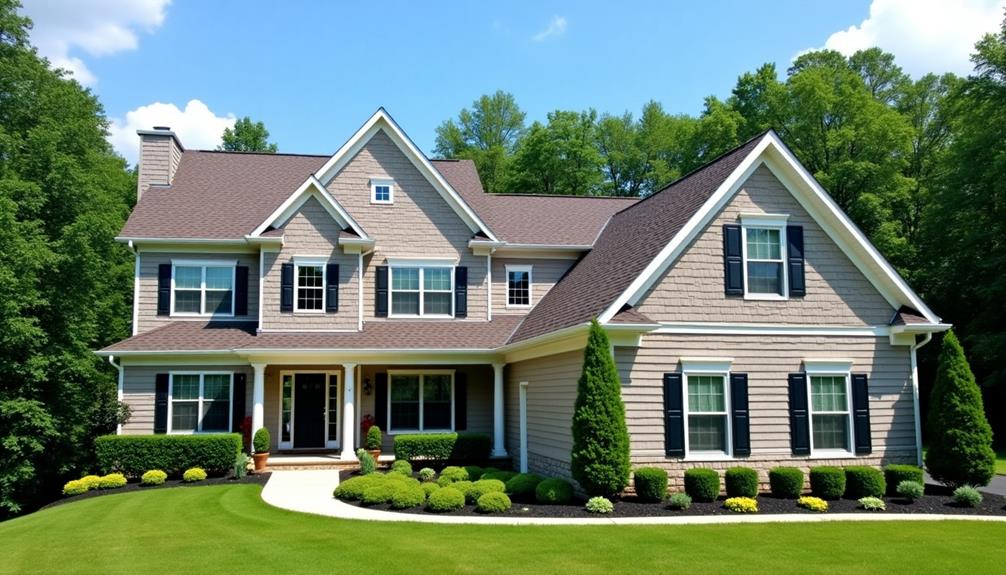If you're facing roof replacement in Hamilton, NJ, recognize key signs such as leaks, damaged shingles, or sagging areas. Costs typically range from $3 to $5 per square foot, depending on material choice and size. Asphalt shingles are popular for their affordability, while metal options offer longevity. Finding a reliable contractor is crucial; check reviews and verify licenses. Preparation is also important: clear your property and communicate timelines with your contractor. This investment not only enhances curb appeal but also boosts energy efficiency. There's much more to uncover about ensuring your project goes smoothly and meets local codes.
Signs You Need a Roof Replacement
Over time, your roof can show signs that it's nearing the end of its lifespan, and recognizing these indicators early can save you from costly repairs down the line.
One major sign is the presence of leaks. If you notice water stains on your ceilings or walls, it's crucial to conduct leak detection as soon as possible. This could indicate that your roof's protective layer is compromised, so addressing it quickly can prevent further damage.
Another sign is missing or damaged shingles. If you spot cracked, curled, or missing shingles, your roof may not be effectively shielding your home from the elements.
Additionally, check for granule loss in your gutters; this is a sign that your shingles are deteriorating and may need replacement.
Understanding Roof Replacement Costs
When planning a roof replacement, understanding the associated costs is crucial for budgeting effectively. Several cost factors can influence your overall expense, including the size of your roof, the materials you choose, and labor costs. Additionally, roofing insurance can play a significant role in managing these expenses, as it may cover part of the replacement costs.
Here's a breakdown of some common cost factors:
| Cost Factor | Estimated Range |
|---|---|
| Roof Size | $3 – $5 per sq. ft. |
| Material Type | $100 – $1,000 per sq. |
| Labor Costs | $50 – $150 per hour |
| Disposal Fees | $300 – $600 |
Choosing the Right Roofing Materials
Selecting the right roofing materials is essential to ensure your home is both durable and visually appealing. You'll want to consider various factors, such as climate, budget, and aesthetics.
Asphalt shingles remain a popular choice due to their affordability and versatility, but keep an eye on the latest roofing trends. Metal roofing is gaining traction for its longevity and energy efficiency, making it a smart investment.
If you're keen on sustainability, don't overlook eco-friendly options like recycled shingles or green roofing systems. These materials not only reduce your carbon footprint but can also improve your property's energy efficiency.
Many homeowners are now opting for solar panel-integrated roofs, providing a dual function of energy generation and protection.
When choosing your roofing materials, consider the warranty and lifespan; higher-quality materials often come with better guarantees. Research local building codes and regulations to ensure compliance.
Benefits of Roof Replacement
Investing in a roof replacement offers numerous advantages that can significantly enhance your home's value and performance. One of the most compelling benefits is improved energy efficiency. A new roof, especially when paired with modern insulation materials, helps regulate your home's temperature, reducing your reliance on heating and cooling systems. This not only lowers your energy bills but also contributes to a more sustainable environment.
Additionally, a roof replacement can dramatically boost your home's curb appeal. A fresh, well-installed roof enhances the overall aesthetic of your property, making it more attractive to potential buyers if you decide to sell. Homes with appealing roofs often command higher resale values, providing a solid return on your investment.
Moreover, a new roof offers peace of mind, as it reduces the risk of leaks and water damage. This protection can save you from costly repairs down the line.
Finding Reliable Contractors
A successful roof replacement hinges on finding the right contractor who can deliver quality workmanship and reliable service. You'll want to conduct thorough research to ensure you're making an informed choice. Start by checking contractor reviews online; these can provide valuable insights into a contractor's reputation and the experiences of previous clients.
When evaluating potential contractors, consider the following key factors:
| Factor | Importance |
|---|---|
| Experience | Look for contractors with a proven track record in roof replacements. |
| Service Warranties | Ensure they offer warranties that cover both materials and workmanship. |
| Licensing | Verify that the contractor is licensed and insured for your peace of mind. |
| Communication | Choose someone who communicates clearly and promptly throughout the project. |
Preparing Your Home for Replacement
Preparing your home for a roof replacement involves several important steps that can help ensure a smooth process. Start by reviewing your roofing timeline with your contractor. Knowing the expected start and completion dates will help you plan accordingly.
Next, create a homeowner checklist to keep track of tasks. Clear your driveway and surrounding areas of any vehicles, patio furniture, or decorations, as these can become hazards during the project.
If you have pets, make arrangements to keep them indoors or away from the worksite for their safety.
It's also crucial to protect your property. Cover plants and landscaping with tarps to shield them from debris.
Inside your home, secure fragile items and move valuables, especially those located near the attic or ceilings, to avoid potential damage from vibrations.
Maintenance Tips for New Roofs
To keep your new roof in top condition, regular inspections are essential.
You should also prioritize cleaning debris effectively to prevent damage and maintain drainage.
Additionally, addressing minor repairs promptly can save you from more extensive issues down the line.
Regular Inspections Importance
Regular inspections are crucial for maintaining the integrity of your new roof and can save you significant costs in the long run. By staying proactive and scheduling these inspections, you can identify potential issues before they escalate into costly repairs. Aim for a minimum inspection frequency of twice a year, ideally in the spring and fall, to catch seasonal wear and tear.
These regular check-ups act as preventative measures, allowing you to monitor the condition of shingles, flashing, and gutters. During these inspections, watch for signs of damage such as cracked shingles, rusted flashing, or clogged gutters. Addressing these problems promptly can prevent water intrusion, which can lead to mold growth and structural damage.
Additionally, consider hiring a professional inspector who can provide a comprehensive assessment of your roof's condition and identify less obvious issues. Investing time and resources into these inspections not only extends the lifespan of your roof but also enhances your property's overall value.
Don't wait until the damage is evident; prioritize regular inspections to protect your investment and ensure peace of mind.
Cleaning Debris Effectively
Maintaining the condition of your new roof goes beyond just regular inspections; cleaning debris effectively plays a vital role in its longevity. Regular debris removal not only keeps your roof looking good but also prevents potential damage from mold and mildew. Here are some effective cleaning techniques to consider:
| Technique | Tools Needed | Frequency |
|---|---|---|
| Manual Cleaning | Stiff broom, gloves | Bi-weekly |
| Pressure Washing | Pressure washer | Annually |
| Gutter Cleaning | Ladder, scoop | Seasonal |
For manual cleaning, use a stiff broom to sweep off leaves and dirt. This prevents buildup that can trap moisture. Pressure washing is effective for tougher stains but should be done with care to avoid damaging shingles. Lastly, regular gutter cleaning is essential to ensure water flows freely, preventing overflow that could harm your roof.
Addressing Minor Repairs
Addressing minor repairs promptly can significantly extend the lifespan of your new roof.
It's crucial to regularly inspect your roof for any signs of shingle damage, as even small issues can escalate quickly if left unattended. Look for missing, cracked, or curled shingles, and replace them as needed.
Leak detection is another essential aspect of roof maintenance.
Check your attic for any signs of water stains or dampness, especially after heavy rain. If you notice leaks, act immediately to prevent further damage to your home's structure.
You can also perform routine checks after severe weather events.
Wind can loosen shingles, and debris can create potential entry points for water. Ensure to clear any debris from the roof and gutters to maintain proper drainage and avoid pooling water, which can lead to leaks.
Local Building Codes and Permits
When planning a roof replacement in Hamilton, NJ, have you considered the local building codes and permits required for your project? It's crucial to understand that compliance with local regulations ensures your safety and helps avoid costly fines. Before you begin, you'll need to submit a permit application, which can vary based on the scope of your work.
Here's a quick overview of the typical requirements:
| Requirement | Details |
|---|---|
| Permit Application Process | Submit a detailed plan of your project |
| Inspection Schedule | Schedule inspections at key stages |
| Materials Compliance | Use materials that meet local codes |
| Timeline for Completion | Complete the project within specified time |
Each of these steps helps guarantee your roof's integrity and legality. Ignoring these requirements can lead to complications down the line, including fines or the need for costly rework. So, before you start tearing off that old roof, make sure you're fully informed about the necessary permits and regulations to ensure a smooth and compliant roofing project.

